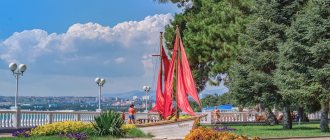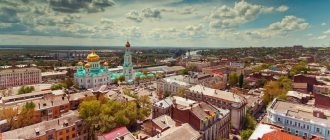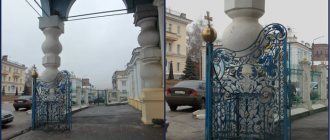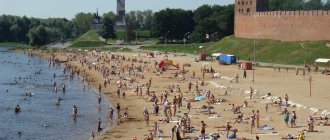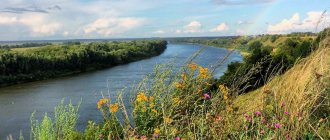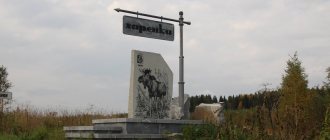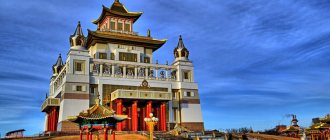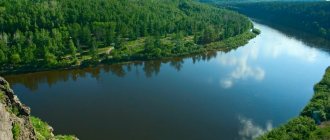Vysokovsk
- a city (since 1940) in the Klinsky district of the Moscow region of Russia.
Population 10.7 thousand inhabitants (2010).
Locality: Vysokovsk city
- Name: Vysokovsk
- Status: city
- Number of inhabitants: 10900
- Applies to: Urban settlement Vysokovsk
Geographical coordinates
- Latitude: 56.314112
- Longitude: 36.556824
- Vysokovsk on the map
Here is located:
- Post office 141650
- Kindergarten No. 17 Mashenka
- Kindergarten No. 18 Malyutka
- Kindergarten No. 20 Vasilek
- Kindergarten No. 21 Rainbow
- Vysokovskaya School No. 1
- Vysokovskaya school No. 4
- CDC Vysokovsk
The city received this name for its location on elevated terrain. The city is located on the Elm River. Railway station 10 km west of Klin and 100 km northwest of Moscow (the railway line from Klin was built in 1914)
Main enterprise -
- spinning and weaving factory (founded in 1883).
- State Unitary Enterprise "Vysokovsky Avtodor"
- Production of Christmas tree decorations (JSC "Yolochka").
- Hunting and fishing farm. Bakery No. 2.
There is a stadium, two secondary schools, a children's art school, the Oktyabr cinema, the Krasny Tekstilshchik CDC, a hospital complex, and a clinic. Mayor of the city Davydov Vyacheslav Evgenievich
Brief history of the city
The initial mention of the tiny agglomeration was in the news for 1914. A railway station was built on the hill, connecting the manufactories located here with the district center itself, that is, with Klin.
Due to the predominance of the relief, the complex of industries was called Vysokovsky, identifying it with a separate village. And it became so in 1928, because thousands of workers needed dormitories, grocery stores and markets, bathhouses and pharmacies. In 1940, the residential area received the status of a full-fledged city. Less than a year later it was occupied by the Nazis, who were rushing to Moscow. The spinning and weaving mill was almost completely destroyed. Other buildings were also damaged.
However, until 1957 the city of Vysokovsk even continued to remain a regional center. However, now it is better known not for the production capacity indicated above, but for the “New Year’s” enterprise “Yelochka”.
Modernity
Today the city has surrounded itself with dachas and vegetable gardens, not really wanting to raise the chimneys of factory buildings into the sky. Even the Vysokovsk-Klin railway line, laid by the factory owners in 1911, experiences almost no load. But the Vysokovsk-Klin asphalt road is working at full capacity. Along it, from the Vysokovsky quarry, every day the mighty KAMAZ trucks transport clay to the Klinstroydetal enterprise, which produces up to 30 million bricks per year.
Products from the asphalt concrete plant, one of the bases of the State Unitary Enterprise MO Vysokovsky Avtodor, are also transported along this road. The company has three of its own bases with a total area of 10 hectares. Avtodor carries out construction, reconstruction, repair and maintenance of highways, production and sale of building materials. Asphalt is mainly used to improve the streets and courtyards of the Klinsky district.
At the moment, the city also operates a factory for the production of Christmas tree decorations “Yelochka”. The factory produces more than 500 items of hand-blown and painted products. Bakery No. 2 is in operation.
More recently (2009), Trocellen RUS LLC, an enterprise producing cross-linked polyethylene foam, opened its doors in Vysokovsk.
The construction of the sports complex that had begun was stopped due to waste of money. Currently, officials explain that the project on which it was built was exactly the same as that of the tragically famous Transvaal Park, so construction was closed.
A new toll highway Moscow - St. Petersburg will pass near Vysokovsk.
Hotels in Vysokovsk
Hotels are also an integral part of local leisure activities. On the street Kuryatnikova, 99 there is a cozy motel. In it, tired wanderers are accommodated in apartments of the “Standard” category. They have a sauna at their disposal, where it is easy to warm up after a walk in inclement weather. You can also frolic in the mini-pool installed there. The bedroom windows overlook the highway leading either to the city of Volokolamsk or to the village of Kirovsky.
Hotels such as Klinskoye Zaozerye are in particular demand. Because vacationers are accommodated in Junior Suite rooms, which are also family rooms. Spacious. There is enough adult and children's furniture with satin bedspreads for everyone.
Around the main building there are gazebos with barbecues, platforms for fishing, a cafe with fresh beer and tandoor, rental of fishing gadgets and bait.
And you can find an attractive 2-level building in the Scandinavian style in Teterino - this is on the south-eastern outskirts of Vysokovsk (just 6 km from it). Along the descending road you will see six lakes, and after a few kilometers (behind Selinsky) you will see the sea formed from the river. Lipnya. Ponds extend from it. They are stocked especially for you. The paths lead into green, fragrant woods.
Finally, the hotel complex “Inspiration”, built at the entrance to Selinskoye (4.5 km from Vysokovsk), invites visitors to stay in not quite ordinary “Standards” and “Luxes” (capacity 2-3 people). The fact is that inside the spacious 3-storey townhouse, made of red brick, everything is subordinated to the “Elite” style - terraces, expensive vintage furniture, a luxurious dining room, paintings in the corridors and tapestries above the headboards, stylish curtains.
For budget travelers, there is also a room with six beds, and it has its own bathroom.
Upon arrival, we recommend making arrangements for breakfast. By the way, it is quite high in calories. Barbecue and fishing equipment can also be rented. The hotel has a regular bathhouse, a Turkish bath and a heated swimming pool.
The city of district subordination Vysokovsk is located in the Klinsky district of the Moscow region on the Klinsko-Dmitrovskaya ridge, on the river. Elm, 99 km northwest of Moscow. Railroad station.
The area of the settlement is 52,256 hectares. As of 2000, 11.8 thousand people lived in the city. (10.7 thousand inhabitants - 2010)
The beginning of the city was laid by a textile factory founded in 1879 by the “Partnership of the Vysokovskaya Manufactory”, at which a village grew up, named after the partnership Vysokoye and the village of New Bazar, which received its name, apparently, for the chaotic nature of its development. In 1864, merchants G.L. Kashaev and I.V. Vasiliev in the village of Nekrasino, part of the Petrovskaya volost of Klinsky district, founded a small factory with 50 machines. Its buildings were wooden and burned down. The owners had to build a new enterprise in 1877, this time made of stone, locating it not far from the same village, on the left bank of the Elm River. There were rich deposits of clay here. The owners built a small brick firing plant, which was used for the construction of factory buildings. Peasants flocked to the factory from the surrounding villages - Polushkino, Timonino, Olisovo, Dmitrakovo.
In the Klin district, the Vysokovskaya Factory was the largest enterprise; the most revolutionary working class was formed here. The first strikes of Vysokovsky weavers occurred in September 1887.
The May Day strike of 1906 was successful at the factory.
At the beginning of the 20th century. Vysokovsk was a typical factory village. In the southern part of it there was a huge long factory building. A single street divided the small territory of the village into two parts. There was a five-year school here. The two-story brick building housed the People's House, which had special boxes for the administration, employees, and a hall for workers.
The Vysokovskaya textile factory continued to be the largest in the Klin district, but it did not operate at full capacity: there were not enough raw materials and fuel. From April 1921, it began to work intermittently; it was decided to send some of the workers to Sankovo peat mining, and the other part to repair workshops.
Life in the workers' village gradually improved. In 1923, a second level school, a factory training school, and a literacy center were opened.
In 1928, several villages merged and were transformed into the workers' village of Vysokovsky.
By the end of the 30s. Vysokovsk was completely radio-equipped; there were 132 telephones operating here. In the eastern part of the village a stadium was built and a summer park was laid out.
In September 1939, the Vysokovsky district was separated from the Klinsky district , it included the lands of Krugovskaya, Petrovskaya, Vladykinskaya volosts, as well as Sankovsky peat mining. The center of this area became Vysokovsk , which received city status in October 1940.
Having become the center of the region, Vysokovsk headed the management of agriculture, which specialized in the production of grain, milk, potatoes and flax. Handicraft industry was widespread in the area. There were three glassblowing artels.
In 1941, the Nazis ruled the Vysokovsky district for 23 days. On December 5, our troops went on the offensive. The army of General D.D. Lelyushenko headed towards the Moscow-Leningrad highway. The 8th Tank Brigade launched an assault attack against the Nazi group located in the village of Yamuga. The Nazis were forced to retreat along a narrow snow-covered road.
December 16, 1941 the city was completely liberated from the fascist invaders, the front line moved to the west. Vysokovsk became a city of the rear and began to restore the destroyed economy.
In 1958-1959 briquette was built.
Since 1972, the factory has been recognized as an enterprise of high production culture and labor organization. Its products (satin, moleskin) are supplied to finishing enterprises in Moscow - the Trekhgornaya Manufactory plant and the Semenovsky finishing factory, as well as to Glukhovsky, Shchelkovsky, Serpukhovsky and other plants. In 1975, the Red Weaver factory, located in the village, was added to the Vysokovskaya spinning and weaving factory. Zubovo.
of Vysokovsk especially changed in the 60-70s. Its borders expanded: in 1960, the village of Nekrasino became part of the city. Housing construction began in the northwest direction along the highway. In place of a vacant lot along the Vysokovsk -Tretyakovo highway, a whole town has risen, symbolizing a new time. The old part of the city has also been transformed; a clinic, new shops, a pharmacy, a school, etc. have appeared here. Much work was carried out to heat residential buildings, and in 1968 gas came to the city.
Yolochka glass Christmas tree decorations factory . Today it is a joint stock company. “Yolochka” is the oldest enterprise that produces Christmas tree toys in our country.
On the border of the Klinsky district and the city of Vysokovsk there is an amazing temple. This is the Church of the Resurrection , an important historical monument. This is an estate church that belonged to the Shipulins ; the entire estate has not survived, but the church remains. It and a natural monument in the form of a landscape park remind of the estate.
in Vysokovsk in 2000, this is the Church of Alexy Tsarevich , briefly called the Alexeevskaya Church.
In addition to the Christmas tree decorations factory and the city-forming weaving factory, the city has a factory producing toys and sports equipment. sports equipment. This is a new plant that will provide employment to local residents, who today are mainly employed in neighboring cities.
The city has an excellent environmental situation. Nature is rich in forests and ponds, lakes, there is a lot of game and wild animals, fish. You can hunt and fish. Specially stocked ponds offer amateurs an excellent catch and a good time for little money. In Vysokovsk, the hunting and fishing industry stands out among the industrial sectors. There are many farms that engage in fishing and hunting in these parts. Vysokovskoe hunting and fishing farm can offer hunters during a special period to hunt wild boar, roe deer, black grouse, wolf, hazel grouse, hare, and marten.
Telephone code: +7 496 24 City portals: https://vysokovsk.narod.ru, https://visokgor.ru City website: https://vysokovsk.nm.ru
Where to eat deliciously
Like all the towns that make up the Klin district, Vysokovsk also has a cafe. The first to demonstrate its level is the eatery behind the Rosneft gas station - it is located right on the “entrance” highway, separated from the highway leading to the village. Kirovsky (talking about Sovetskaya Street). Hungry citizens can expect chips, hot dishes, salads, soft, strong and alcoholic drinks, burgers, hot dogs, and pies.
Having driven along Pervomaiskaya and Vladykino streets to Stachek passage, 1, you will visit the affordable “Casablanca” canteen hidden in a dense public garden. There is barbecue and wine.
Other guests are welcome to sit at the tables of the Pizza Boom pizzeria. The establishment is known for its recipes for 10 “Italian rounds” and good coffee. It is also popular for tea.
Population
| Population | ||||||
| 1897[7] | 1926[7] | 1931[7] | 1939[8] | 1959[9] | 1970[10] | 1979[11] |
| 3700 | ↗8100 | ↗9000 | ↗11 485 | ↘11 057 | ↗12 230 | ↘11 377 |
| 1989[12] | 1992[7] | 1996[7] | 1998[7] | 2001[7] | 2002[13] | 2003[7] |
| ↗11 611 | ↘11 500 | ↘11 400 | ↗11 900 | ↘11 800 | ↘10 950 | ↗11 000 |
| 2005[7] | 2006[7] | 2007[7] | 2009[14] | 2010[15] | 2011[7] | 2012[16] |
| ↘10 800 | ↘10 700 | →10 700 | ↘10 673 | ↘10 635 | ↘10 600 | ↘10 561 |
| 2013[17] | 2014[18] | 2015[19] | 2016[20] | 2017[21] | 2018[22] | 2019[23] |
| ↘10 535 | ↗10 659 | ↗10 676 | ↗10 690 | ↘10 671 | ↘10 586 | ↘10 394 |
| 2020[1] | ||||||
| ↘10 362 | ||||||
As of January 1, 2022, in terms of population, the city was in 904th place out of 1115[24]cities of the Russian Federation[25].
Attractions in Vysokovsk
What to see in Vysokovsk? The main object of the excursion is the Museum of the Christmas Tree Toy Factory. But, for obvious reasons, it is more appropriate to talk about it in the next section.
Not far from the city forest park stands the Church of Tsarevich Alexei (a house with a small domed turret). Opened in 2007, it looks bright and fresh. The current temple is located in the central part of the area. As a result, having completed its inspection, it is easy to walk to the monuments of ancient architecture - residential buildings on Oktyabrskaya, barracks buildings for workers and structures of the Spinning and Weaving Factory. All of them are from the 19th century.
But in the very first (suburban) blocks adjacent to the Kirov Highway, vacationers will stumble upon a “family” of lakes. You need to cross to the other side of the roadway from the Dmitrokovo low-rise development sector. Visitors to this unique natural park will have the chance to walk along forested ponds, swim, and fish.
Literature
1. Charter of the Vysokovskaya Manufactory Partnership. M., 1903. 2. From the history of factories and factories in Moscow and the Moscow province. M., 1968, p. 78. 3. See: Lenin V.I. Poli. collection cit., vol. 3, p. 605. 4. Ibid., p. 605. 5. Labor movement in Russia in the 19th century, vol. 3, part 1. M., 1952, p. 535-560. 6. Revolution 1905-1907 in Russia. The revolutionary movement in Russia in the spring and summer of 1905. April-September, part 1. M., 1957, p. 374. 7. See: Orlov V. Ya. 1905 in Klinsky district. M., 1931, p. 19. 8. See: 1905 in Moscow. Historical and revolutionary essay. Course of events and memorable places. M., 1955, p. 254. 9. The revolutionary movement in Russia in the spring and summer of 1905, part 1, p. 343. 10. Revolution 1905-1907. in Russia. All-Russian political strike in October 1905, part 1. M., 1955, p. 110. 11. See: Zverev A.G. Notes of the Minister. M., 1972, p. 9.12.1917. Chronicle of heroic days. Chronicle of the most important historical, party and revolutionary events in Moscow and the Moscow province. M., 1973, p. 44-45. 13. See: For the power of the Soviets! M., 1957, p. 440. 14. “Worker and Peasant” (Klin), 1918, August 10. 15. Strengthening Soviet power in Moscow and the Moscow province. M., 1958, p. 127-128. 16. Statistical and economic reference book for Klinsky district. Klin, 1924, p. 10. 17. Clubs of Moscow and the province. M., 1976, p. 345. 18. All-Union Population Census of 1926, vol. 55. M., 1931, p. 174-175. 19. Districts of the Moscow region. M., 1939, p. 8. 20. Districts of the Moscow region, p. 62. 21. “Hammer and Sickle”, 1939, September 9. 22. Ibid. 23. “Gazette of the Supreme Soviet of the USSR”, 1940, No. 44, November 6. 24. Districts of the Moscow region, p. 62. 25. “Hammer and Sickle”, 1972, February 22.
- Cities of the Moscow region. Book 2. - M.: Moscow worker, 1980. - 608 p., ill. — 35,000 copies.
Where to go with a child
Your child will thank you if, while in this location, you take him to the museum of the Yolochka factory, which produces Christmas tree decorations.
The manufactory is the oldest in this field, so it opened its own exhibition “Klinskoye Compound”.
A smiling guide will tell the history of the attraction and even show the process of creating Christmas tree balls in the old style of “Klin toys”, that is, she will draw your attention to the work of glassblowers and painting artists. This center has 12 halls. Expensive, but exciting. In addition, you have the opportunity to purchase your favorite products. They are all handmade. And this is the main point. A park of spruce and pine trees is planted around. So the mood here is always New Year's. By the way, back in the century before last, a Christmas tree could be decorated not only with such products, but even with fruits, nuts, and candies.
Speaking of sweets. Cotton candy and puffed corn, kozinaki, ice cream of all kinds - all this variety awaits you in the City Park of Culture and Recreation, operating next to the city hospital. On the territory there is a monument and a cascade of ponds (Kholodny, Teply - on the Elm River). Sidewalks, benches, lots of greenery. First of all, you should appreciate the huge playground with dozens of play complexes and swings. At the height of the warm season, even several inflatable attractions are installed. Either way, it won't be boring.
Children's entertainment is also available at the Materik shopping center, located next to the stadium. And visitors to the “Cultural and Leisure Center” on the street. Lenin is always counted on for children's performances or showing cartoons. During the winter holidays, Father Frost's workshop operates here. Both establishments are located in beautiful buildings dating back to the 19th century.
Climate
| This section is missing references to information sources . Information must be verifiable, otherwise it may be questioned and deleted. You can edit this article to add links to authoritative sources. This mark was set on December 29, 2022 . |
The prevailing climate is moderate continental. The average annual precipitation is 768 mm.
| This section of the article has not been written . According to the plan of one or more Wikipedia contributors, a special section should be located in this place. You can help by writing this section. |
